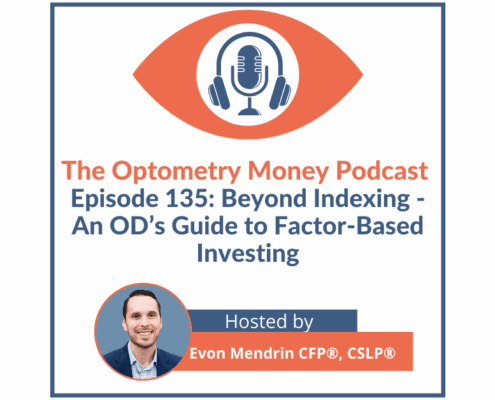The Optometry Money Podcast Ep 107: Investing at Stock Market All-Time Highs
Questions? Thoughts? Send a Text to The Optometry Money Podcast!
With a new stock market all-time high earlier this year (2024), Evon provides perspective from history to put new record highs into proper context.
While it’s often thought that you should avoid investing at all-time highs do to some inevitable crash, ultimately, all-time highs are more common than you think. And the performance of stocks (on average) after new record highs would surprise you. Evon ends with the importance of keeping a long-term investing perspective while planning for a long-term investment goal – financial independence.
Have questions on anything discussed or want to have topics or questions featured on the show? Send Evon an email at podcast@optometrywealth.com.
Check out www.optometrywealth.com to get to know more about Evon, his financial planning firm Optometry Wealth Advisors, and how he helps optometrists nationwide. From there, you can schedule a short Intro call to share what’s on your mind and learn how Evon helps ODs master their cash flow and debt, build their net worth, and plan purposefully around their money and their practices.
Resources mentioned on this episode:
- DFA: Why A Stock Peak Isn’t A Cliff
- RBC GAM: Investing at All-Time Highs
- Optometry Wealth Advisors – Schedule a Consultation
The Optometry Money Podcast is dedicated to helping optometrists make better decisions around their money, careers, and practices. The show is hosted by Evon Mendrin, CFP®, CSLP®, owner of Optometry Wealth Advisors, a financial planning firm just for optometrists nationwide.
Subscribe to our podcast below!
Episode Transcript
Episode 107 Transcript – Investing at Stock Market All-Time Highs
[00:00:04] Evon: Hey everybody. Welcome back to the Optometry money podcast. Where we’re helping ODs all over the country, make a better and better decisions around their money, their careers and their practices. I am at host Evon Mendrin, Certified Financial Planner(TM), and owner of Optometry Wealth Advisors, an independent financial planning firm just for optometrists nationwide.
[00:00:25] And thank you so much for listening today. Really appreciate your time and attention. And today we’re going to talk all about all time highs because earlier this year, 2024, we had yet another all time high in the stock market.
[00:00:39] And this usually leads to this showing up in the news headlines as if it’s something that you need to be aware of and do something about. News headlines usually bring this to your attention as is, as if it’s something you really need to be focused on, concerned about.
[00:00:54] So , what do all time highs in the stock market actually mean for optometrists? Should you be fearful of all time highs. do they automatically mean that a decline is inevitable? As you might hear the phrase, what goes up must come down as if there’s some sort of law of gravity on the prices of stocks that forces them, drags them downward. or as I’ve seen questions of, you know, I have a lump sum to invest. should I really be investing it at all time highs?
[00:01:26] Well, fortunately, I’m here to tell you that an all time high in stock prices isn’t something you really need to be concerned about, and it definitely doesn’t mean that a big decline is sure to come.
[00:01:38] History of All Time Highs in the S&P 500
[00:01:38] Evon: all time highs. When you look back historically are actually pretty common. And we’re going to talk mostly about the S&P 500 today, an index or a list of among the largest 500 companies in the United States.
[00:01:52] And. It’s definitely not the whole stock market, but most of optometrists will be familiar with it. It’s a pretty big chunk of the U.S. Market. And we have a lot of good data going back pretty far.
[00:02:04] So we’re going to talk a lot about,mostly the S&P 500 today. And. With the S&P 500 since 1950. There have been a 1,250 all time highs along the way. Which is an average of roughly 16 every year. And it ranges by decades.
[00:02:25] So 1950s, there’s about 137 of them. 1980s, 189, 1990s, 310, a lot more there. 2013, not surprising. That was sort of that “lost decade” where the S&P 500 returns were pretty much flat. 2010s over 200, 2020s over a hundred. So it does vary by decade, but over that whole time period, around 1,250.
[00:02:49] And it sort of stands to reason just statistically that we should expect to see highs in stock prices over time. The majority of years have positive returns. but stating that this is a usual occurrence, doesn’t get clicks. Right. It’s not going to force you to click that article doom sells, unfortunately.
[00:03:09] So you won’t see “business as usual” in a headline anytime soon.
[00:03:13] The concern you see though. And the concern that’s often sort of inferred, that’s hinted at, in a lot of these. the media pieces or, or sound soundbites or video clips. Is that since prices are high, since prices have gone up. A decline is inevitable. That it’s inevitable you’re going to see poor returns from here on out. Get ready. Right. Sell out. Now’s the time, something like that. That’s usually what is going to be, either explicitly or implicitly stated, but that’s not necessarily the case. In fact, when you look at average returns after all time highs, it’s not what you would expect.
[00:03:53] Dimensional Fund Advisors has a piece that I’m going to link to in the show notes that looks at all monthly return data. From the S&P 500 from 1926 through 2023. And they look at the average annual returns of the S&P 500. One year, three years, and five years after months that ended at record highs. So we’re looking at what happened one year, three year and five years. After a month that had an all-time high after a record high. And as it turns out all time, highs are followed by more record highs on average.
[00:04:34] That is on average, right? Not every time, but on average, that’s the case. when you look at the data here, what they show is that. After a record high, the average return one year later for the S&P 500. Was almost 14%, 13.7%. Three years later, the average annual return was 10.6%. Five years later, the average annual return was 10.2%. Not too bad considering the, the, You know, the scariness and doom and gloom that you tend to see around this.
[00:05:07] And even more what’s fascinating is that they compare this to the average returns one, three and five years after months that ended on any level, meaning they compare what happens after record highs versus what happens if you invest on any given month. And there’s no material difference between the two. One year after the returns are actually a percent higher on average after record highs than on any given month, but three and five years later, they’re within a percent difference.
[00:05:38] It’s actually pretty close. Again, probably not what many of you may have been expecting? I think many expect poor performance in the short term, right? But history shows that that’s not quite the case. that within a relatively short time period, after all time highs, one to five years later, that hasn’t been this material difference in average annual returns versus any other given month on average. And so I hope this helps to kind of settle you down from any potential doom and gloom, you might see out there. And I’m personally thrilled about all time highs, you know, otherwise, why am I investing?
[00:06:15] It means that investors are doing well likely that businesses and the economy is doing well. and since over time, stock returns tend to follow earnings. It probably means over time that businesses are profitable.
[00:06:29] How Often do Corrections Follow All-Time Highs?
[00:06:29] Evon: But what about those declines?
[00:06:31] You know we talk about the average returns, but what about big corrections? How frequent are market corrections after all time highs, I’m gonna link to data from RBC global asset management in the show notes as well. this is only going from 1950 to 2023. So it’s not quite as a lengthy time period, but what they find is that one year later, only 9% of all time highs were followed by a decline of 10% or more. So only 9% were followed by a true correction. three years later, only 2% and then five years later, 0%.
[00:07:06] So it’s actually has been very uncommon, at least in this dataset historically, right. It’s actually been very uncommon that all time highs have been followed by a pretty substantial decline. Again, this is historical data. This does not guarantee that this is what’s going to happen in the future. past performance is not indicative of future performance, but it does give us a reasonable expectation for what might happen as these events occur.
[00:07:33] Declines Happen, But That’s Just Part of Investing
[00:07:33] Evon: But that doesn’t mean stock markets will continue giving you positive returns forever. there is some cyclicality to it.
[00:07:40] If markets are on an extended increase or an extended bull run. We should have some expectation that returns are going to pull back. I mean, simple math would suggest that if the average annual return is mid to high single digits or so. And that if returns are much higher than that, there needs to be some regression to the average. It needs to be some adjustment to that. We should not expect you have forever higher than average returns.
[00:08:08] So that does make sense. And that’s part of investing. That’s simply a part of investing.
[00:08:13] We are putting our money at risk. We are investing our dollars so that over long periods of time, it will outpace inflation and help us to meet our financial goals. And you’re doing that without taking undue risk, but you are putting your dollars at some uncertainty and at some degree of risk. Declines are common.
[00:08:33] And in fact, when you look throughout history, you know, a 10% loss or so you should expect on average every 12 months or so. There’s probably an annual expectation is some, a low double digit decline on average. 20% drops, you might expect to see every three and a half to four years, 30% or more drops probably about once a decade. So these are things you’re going to experience as long-term investors throughout your life.
[00:09:00] But since we are long-term investors, we’re not really concerned about what our investments are doing on any given one day period or one year period, or realistically over a five-year period. We’re concerned about what our investments are going to do over the next 20 and 30, 40, 50 years of our life. That’s what our return expectations are as we’re investing for longterm financial independence. And so while w while it’s not fun to go through these declines,
[00:09:29] We can benefit from them by staying invested and continuing to invest. And seeing the likely rebound on the other side.
[00:09:36] And realistically, since we are long-term investors. All time highs really aren’t aren’t anything to take note of. I mean, it’s not really anything to be. To me. It’s not newsworthy. It’s not something I’m thinking about or concerned about, or really talking to clients about.
[00:09:51] This short-term performance stuff is just not.
[00:09:53] It’s just not of concern to me because we are long-term investors.
[00:09:57] What Should Optometrists Focus On
[00:09:57] Evon: So, what should we do? Well? Ignore the noise, right? Ignore the, the media soundbites or headlines or video clips, all about doom and gloom. Just kind of put that out of your mind. but most importantly, you want to focus on your own financial plan. What are your goals and what are the purposes for your investments?
[00:10:16] You want to have a sound strategic long-term mix of investments that fits your life and your circumstances and your investment goals. Having an appropriate mix between stocks and real estate versus bonds. And even within stocks and bonds, having a right appropriate balance of the different categories. Large and small stocks within the U S and internationally. all the different characteristics of stocks. You want to have the appropriate long-term mix of investments that fits your circumstances and your investment goals.
[00:10:48] And then simply stay invested. Taking less action is is most likely going to be the best course of action. And only doing that normal maintenance, such as rebalancing that is trimming the categories that are too high relative to your target, or, and then adding back to the categories that are lower than you’re targeting, ultimately to maintain your risk long-term, or tax planning opportunities in non-retirement accounts, those things are normal maintenance that are appropriate, but for the most part, simply stay invested and then focus your efforts, your energy on the things that are actually within your control. Your job and your career. If you own a practice focusing on your practice or other businesses, focusing on your savings rate, how you use your cashflow, how much of your income are you turning into assets by investing. Those things are where it makes sense to put your additional time and concern and stress and energy.
[00:11:46] And hopefully this is helpful to give you some context around. These record highs as they come throughout your investing career. And as you see again, the headlines and the soundbites about this, and as you have questions about man, I’ve got this money, should I really be investing?
[00:12:01] Getting now? And what’s fascinating is that. Although many are concerned about investing at an all time highs. People are just just as concerned when the prices are declining and, and prices have declined. And you know, these things go on sale. So whether prices are high, whether prices are low, there’s always going to be some reason for concern.
[00:12:20] But stay focused on your goals and on your long-term investment. strategy. And try to just push the noise away.
[00:12:27]
[00:12:28] Evon: If you have any questions or ideas or questions for future episodes, maybe we’ll have a mailbag episode coming up soon. If we have enough questions, you can reach me here at podcast@optometrywealth.Com.
[00:12:40] You can check out the links I mentioned and resources mentioned in the show notes, which you can find at the education hub at my website, www.optometrywealth.Com. And while you’re there, feel free to check out all of the other articles and resources and episodes we’ve done. As well as schedule a no commitment, introductory call. We can talk about all of this fun stuff and anything that’s on your mind financially. And I can share how we serve optometrists navigate their most important financial decisions nationwide. And with that, we’ll catch you on the next episode. In the meantime. Take care.

RECENT POSTS
- The Optometry Money Podcast Ep 138: The Big Beautiful Bill Act – Tax & Student Loan Reforms Optometrists Need to Watch
- The Optometry Money Podcast Ep 136: Creating a More Holistic Integrated Healthcare Patient Experience with Dr. Neda Gioia
- The Optometry Money Podcast Ep 135: Beyond Indexing – An Optometrist’s Guide to Factor-Based Investing
- The Optometry Money Podcast Ep 134: The Case for Index Funds – Why Optometrists Should Embrace Passive Investing
- The Optometry Money Podcast Ep 133: Strategic Tax Planning Levers in the Optometrist’s Tax Return

 Optometry Wealth Advisors LLC
Optometry Wealth Advisors LLC Optometry Wealth Advisors LLC
Optometry Wealth Advisors LLC Optometry Wealth Advisors LLC
Optometry Wealth Advisors LLC
 Optometry Wealth Advisors LLC
Optometry Wealth Advisors LLC Optometry Wealth Advisors LLC
Optometry Wealth Advisors LLC